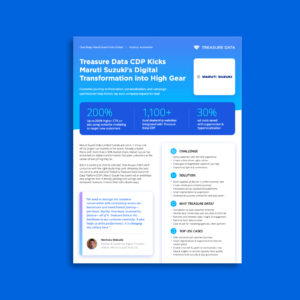Executive summary
Sumitomo Mitsui Banking Corporation (SMBC), a core company of the SMBC Group, is promoting customer-oriented digital marketing to drive long-term customer engagement. As part of this effort, it is leveraging Treasure Data CDP to develop scenarios that deliver optimally timed messages to precise customer segments. A more personalized customer experience is being realized. We asked two of SMBC’s key figures about their aims and strategies for advanced digital marketing.
Key points of this customer story:
- Improved customer engagement by leveraging Treasure Data CDP to deliver the right message at the right time based on customer data.
- Utilization of the Treasure Data Journey Orchestration tool is enabling consistent marketing campaigns throughout the customer lifecycle.
- Increased conversion rates through ongoing data analysis and customer-oriented marketing campaigns.
Challenges
Since 2019, SMBC has been using Treasure Data CDP to streamline its marketing operations.
Sumitomo Mitsui Banking Corporation is one of Japan’s leading financial institutions. It is actively promoting the digitization of financial services. Since the launch of the Sumitomo Mitsui Banking smartphone app in February 2013, it has been working to improve the service, and the app has been downloaded over 15 million times. SMBC is also releasing other new apps one after another.
It is the role of the Digital Marketing Planning Group in the Retail IT Strategy Department to promote use of these apps and improve customer engagement.
In 2019, SMBC introduced Treasure Data CDP to streamline its digital marketing activities. Hirokazu Makino, who works in digital marketing, reflects on the reasons for this:
“Since launching the Sumitomo Mitsui Banking app, we have been promoting joint creation across SMBC and beyond the Group, and have launched a variety of apps and services. But to improve engagement, it is important to run the PDCA cycle to identify and resolve issues. Data analysis is critical to this. However, previously, data was collected separately from each channel. For example, web or email data and delivery scenarios had to be adjusted and set manually by our staff. Our primary goals were to reduce this workload and streamline operations.”
Solution: Introducing Treasure Data Journey Orchestration to improve delivery design and realize customer journeys
SMBC is not only using Treasure Data CDP to build a foundation for data collection, integration and analysis, but is also actively using it to segment customers and in marketing activations. This has helped to automate tasks that had previously been done manually. But to promote customer-oriented digital marketing, a more advanced strategy was needed. This was because there was a lack of coordination between the services.
Makino explains, “We were sending messages about new apps, new feature releases, how-to information, and use-to-earn points systems, but we had separate measures for each service. Customers would receive similar messages from SMBC many times, which could be unpleasant and create a sense of distrust.”
We were creating and modifying message delivery scenarios in SQL using Treasure Data CDP, but there were more than 100 scenarios. “Several people, including myself, supported the staff in charge of each service by doing maintenance work, such as adjusting the timing of delivery, but that was taking up all our time. It was difficult to analyze data and try out new measures. There were a limited number of people with the skills to handle SQL, so the work tended to depend on the efforts of those few individuals,” recalls Makino.
It was to alleviate these challenges that SMBC adopted the Treasure Data Journey Orchestration feature. “We were attracted by the fact that we could create and modify delivery scenarios using an intuitive GUI without SQL coding,” Makino says.
There was one more important reason: SMBC wanted to develop a consistent marketing strategy throughout the customer lifecycle to optimize the customer experience. “We conducted a PoC prior to introducing the feature and were able to confirm its usefulness,” says SMBC’s Yuu Nagashima, Manager of the Digital Marketing Planning Group.
Since the introduction of Journey Orchestration coincided with a period of improvement of marketing campaigns for each service, including the Olive app, the first initiative was an Olive-themed measure.
“When introducing new services, are we effectively reaching customers with latent needs? We used Journey Orchestration to do this,” says Nagashima.
Results: Easier to experiment with different measures. Conversion rates are also rising.
SMBC has just introduced the Journey Orchestration tool, but it is already seeing concrete results.
Makino discusses the advantages of the tool, stating that “The GUI-based creation and modification of delivery scenarios allows us to create and modify delivery scenarios with the flexibility to, for example, target content by customer segmentation and response, and to change delivery timings from weekly to daily. Once we have set up a scenario, the delivery process can be automated. It’s easier to try out activations from different directions. In addition to streamlining operations, we have also expanded the range of our work.”
In terms of campaign management, SMBC has formulated rules to balance customer-oriented design and distribution frequency. “We have adopted a strict rule whereby we first implement measures on an experimental basis, and only set up official automated scenarios in cases where customers respond well,” Nagashima says.
They are still at the stage of collecting a wide range of data, but have seen a definite response. “By switching between a range of content formulas and by experimenting with delivery timings, we have seen improved conversion rates,” Nagashima says.
Treasure Data support has also been very helpful in using Journey Orchestration. “They gave us detailed support, not only on how to use product features, but on how to collect and integrate data. This support has helped us better understand and make better use of this product.” As Makino reflects, “This initiative has also raised awareness of Journey Orchestration within the organization, and the increase in users has also enhanced our digital marketing.”
They have also experienced some unexpected benefits from using Journey Orchestration. Nagashima elaborates as follows.
“The GUI-based creation of delivery scenarios allows team members to communicate smoothly, regardless of whether or not they have SQL skills. For example, when considering campaigns, people now come together and exchange opinions naturally. Everyone participates, so there is a broader range of ideas and viewpoints. This is a happy accident. It makes team members more motivated.”
Makino adds, “Our work has expanded: rather than simply doing SQL maintenance, we are now thinking up new delivery scenarios. We’re very motivated.”
Shifting to a data-driven approach and rolling out successful models
SMBC will now analyze scenario delivery results to identify issues and derive insights, and apply what they learn to future campaigns. Successful models will be rolled out to the digital marketing of other services.
Makino states, “Through this initiative, we have reaffirmed the importance of timing in delivering messages to our customers. The same message will come across differently at different times and in different situations. We want to back this up with data and further refine our customer segments.”
As they gain more insights, SMBC’s digital marketing will become more sophisticated. Looking to the future, Nagashima explains, “Once we get insights from data, we will be able to use this tool in more ways, such as to uncover latent demand. We will continue to try out a range of measures.”
Sumitomo Mitsui Banking Corporation’s initiative is attracting a lot of attention from throughout the financial sector.



